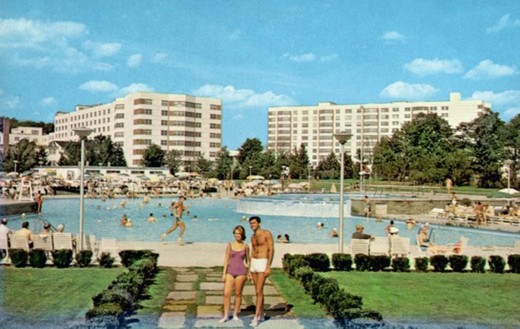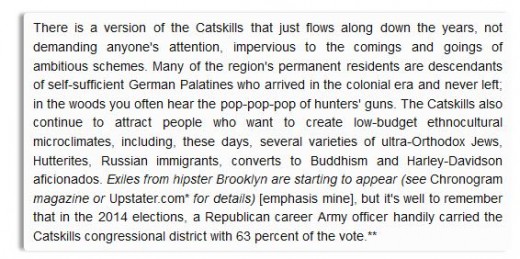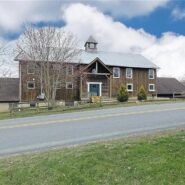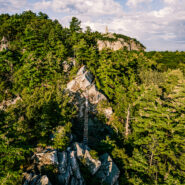This Way for Details on Exiles from Hipster Brooklyn
Brian Mahoney | January 7, 2016
FROM “THE CATSKILLS: ITS HISTORY AND HOW IT CHANGED AMERICA” – A postcard shows the Concord Hotel resort in the Catskills, circa 1960.
[This piece originally appeared on Chronogram.com.]
Late one Sunday afternoon in early December, Lee Anne, Shazam, and I were at home, engaged in our usual routine. Lee Anne was finishing up the crossword in the New York Times Magazine. Shazam was curled up on the couch between us, three tennis balls hoarded Smaug-like between his paws and belly. I was skimming through the rest of the paper, attempting to stay minimally informed about politics, international news, arts and culture, sports, real estate, and business—and to see if I knew anybody who got their wedding covered in the Times. (And no, no one I know has been featured in the paper’s Wedding section.)
Leafing through the Book Review, I spied a piece on a book we had written about in the November issue, The Catskills: Its History and How It Changed America by Stephen M. Silverman and Raphael D. Silver. Imagine my surprise, reading the review, when I came across a mention of Chronogram. “Good heavens!” I cried in shock and amazement. Shazam awoke with a start and leapt off the couch, looking for the source of the commotion, sending tennis balls rolling across the living room floor in three directions, which became its own source of commotion and vexation for the dog as one of the balls rolled underneath our home entertainment center, the area known to Lee Anne and me as the tennis ball mausoleum.
“What is it, darling?” Lee Anne asked, knowing how riled up I can get reading about the weddings of the children of the one percent.
“Chronogram has been mentioned in the New York Times!” I said, trying not to exclaim. (Lee Anne and I are not in agreement on this bit about whether I exclaimed or not.)
“Wonderful,” she said. “Why don’t you read it to me?”
Before I puffed out my chest and began to declaim, I explained some of the context: The Catskills: It’s History and How It Changed America is a popular history building on the work of Alf Evers and others, containing many colorful characters, but no original research, and much of the book is spent on the post-World War II heyday of the Jewish Catskills. All of this according to the reviewer, New Yorker staff writer Nicholas Lemann, whose review, tepid at best, was less about the book than Lemann’s big thoughts about the Catskills. Such as: ideas about pristine wilderness and tourism have been intertwined since the early 19th century, when “the mountains were attracting tourists before they were a supposedly untouched paradise—indeed, the second identity resulted from the first”; the country and the city are a beast with two backs, “a single entity created in tandem, rather than two separate realms”; and anyone expecting an imminent economic comeback in the Catskills from the creeping influx of downstate creative is going to have to wait a long time. (Lemann’s last point, about the pace of economic development, is spot-on, and I would add that those proclaiming otherwise are naïve at best and cynical hucksters at worst.)
Here’s what I read to Lee Anne, from the third-to-last paragraph of Lemann’s review in the December 6 New York Times Book Review:

But as I read it again, my exultation began to fade. The words exiles + hipster + Brooklyn + Chronogram tasted sour as I said them. While I was pleased that our little provincial magazine is on the radar of New York City media elites, is this the way Chronogram is perceived, as the house organ of hipster exiles? As my colleague Kandy Harris noted about this on Upstater.com, the Times is infamous for calling the Hudson Valley “the new Brooklyn” on multiple occasions.
I slumped back onto the couch, deflated. Lee Anne could see that what I first had viewed as an unqualified triumph was now a multivalent thing, full of meanings and interpretations beyond my control. “Don’t let the bastards get you down,” Lee Anne said, and kissed me on the cheek.
As far as Chronogram is concerned, I invite you to have a look at this issue and ask yourself how the magazine stacks up against the claim that we’re chronicling the Brooklynization of the Hudson Valley. I don’t remember seeing any self-identified Brooklyn expats profiled here, but I could be wrong I’m curious to know what you think about this. Please e-mail your comments and suggestions to me at brian@chronogram.com.
* Upstater.com and Upstater magazine are also published by Chronogram’s evil corporate overlord, Luminary Media. We infiltrate Brooklyn, Manhattan, and Queens on a quarterly basis with 50,000 copies of Upstater as part of a counter-insurgency targeting unsuspecting hipsters where they expect it least—in their own craft beer boutiques, granny dress shops, ramen burger restaurants, and mustache wax emporiums.
** A quibble with Lemann’s interpretation of the 2014 election: The career Army officer in question, Rep. Chris Gibson (one of the most moderate Republicans in Congress), ran against a 27-year-old named Sean Eldridge, who just happened to be completely untested, gay, married to a billionaire, born in Canada and raised in Ohio, and a recent transplant to the region. It felt as if someone had fashioned Eldridge directly from a “Build a Perfect Carpetbagger” kit. Looking forward to 2016, Gibson says he’s not running, so it seems likely that the seat will fall back into Democratic hands, with Ulster County Executive Mike Hein defeating one of a number of little-known regional Republicans. It’s worth remembering that before Gibson was elected, the area was represented for 20 years by progressive Democrat Maurice Hinchey.
Read On, Reader...
-

Jane Anderson | April 1, 2024 | Comment A Westtown Barn Home with Stained-Glass Accents: $799.9K
-

Jane Anderson | March 25, 2024 | Comment A c.1920 Three-Bedroom in Newburgh: $305K
-

-

Jaime Stathis | February 15, 2024 | Comment The Hudson Valley’s First Via Ferrata at Mohonk Mountain House

